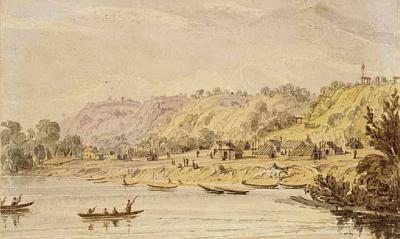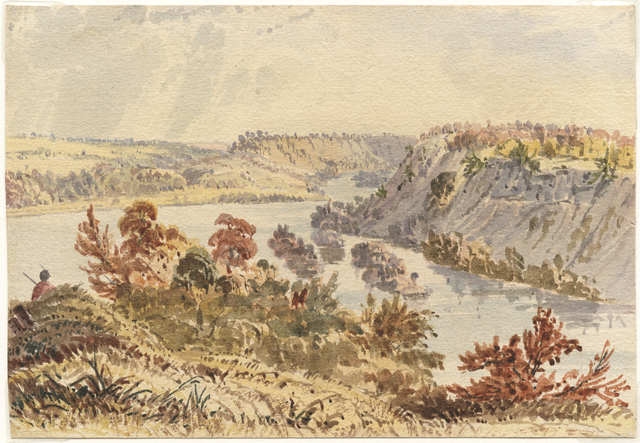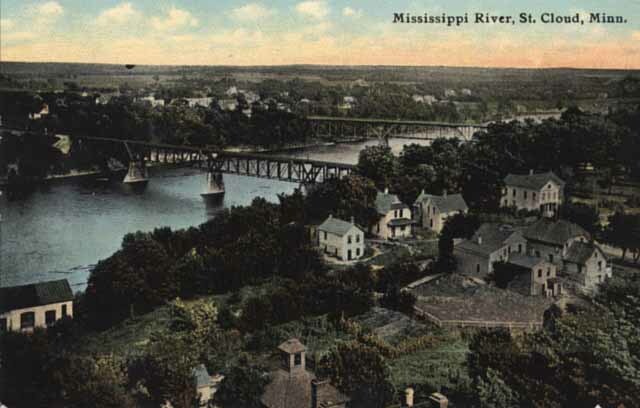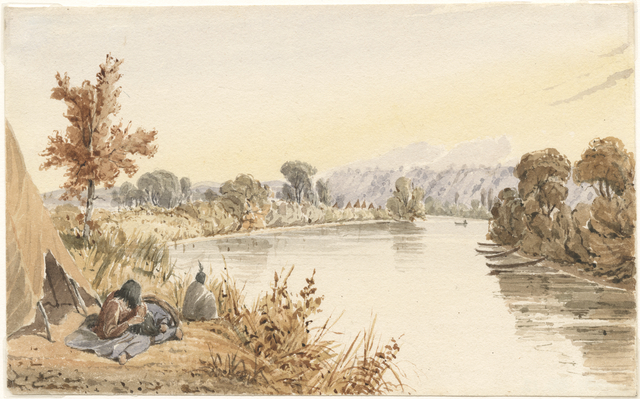Mississippi River
Economy and Trade
It is undeniable that the Mississippi River has played crucial roles in the survival, and sustenance of human populations in North America. Stretching nearly the entire longitudinal length of the United States, it has served purposes relating to spirituality, trade, transportation, food, and an abundance of other cultural and traditional practices. This is especially true for Native populations within the Mississippi River Valley, whose ancestors have been utilizing the immensity of the river for much longer than any source of documentation can account for. In the state of Minnesota, the confluence of the Minnesota and Mississippi River is particularly important to the Dakota, the Indigenous peoples of this region. This place is known as the Bdote, and according to Dakota origin stories, “The first place of creation is at the confluence of the Minnesota and Mississippi rivers, where the Dakota people came from the stars to be on the earth...The Earth opened herself in that way, and from the mud the Creator made the first Dakota man and woman,” (Westerman & White, 2012, p. 19). Although it is clear that the Mississippi River plays an immense role in cultural identity for many Indigenous Nations, the river holds great value in the area of commerce, as well. In this article, we will highlight the economic value of Mississippi River in relation to Native Nations in this region before and after they encountered European fur traders.
Well before the arrival of settlers, Native Americans in this region had long established a commercial trading system, that was largely dependent on the Mississippi River. Prairie du Chien, located down-river in present-day Wisconsin, was one nearby site where American Indian Nations from the Mississippi River Valley and beyond would meet annually for trade fairs (Relationships). Later, these popular meeting places would become major hubs of the fur trade which fueled the economic engine for the region. Using the river as a means of travel, Native Americans would construct birch bark or dug-out canoes to use when traveling from village to village, (Peterson & LaBatte, 2014). The river served as a great resource for catching fish and other river-dwelling animals, such as beaver and muskrat. Establishing villages along the riverside was common for the utilization of these many resources, and for the ease of making agreements and trade with other tribes.
Once Europeans arrived in the Mississippi River Valley, trade and economy increased dramatically between Native Americans and Europeans. Dakota and Ojibwe, "harvested a wide variety of furs (beaver being the most valuable) in the region's woodlands and waterways. In exchange for these furs, French, British and U.S. traders provided goods such as blankets, firearms and ammunition, cloth, metal tools and brass kettles,” (The Fur Trade). Both the Ojibwe and Dakota Nations played equally important roles in the Minnesota fur trade. As the Ojibwe traded resources gathered in mixed forests of the northern portion of Minnesota, the Dakota traded resources gathered in the prairies and broad-leafed forests of the southern portion of the state. With the arrival of the horse on the plains in the 1700s, trade began to increase even more rapidly. Dakota living on the prairies of Minnesota soon became advanced horse trainers, and could greatly expand their hunting territories and thus, fur collection. The survival of the fur trade in Minnesota depended largely on the Mississippi River, as this was the primary connection between this area and the outside world. With the increase in trade, steamboats would soon be seen along the river carrying the increased loads down-river to major exporting sites in St. Louis (Gilman, 1989).
Important trading posts within the St. Cloud region were the Watab and Sauk Rapids Trading Posts. The Watab Trading Post, established just north of Sartell in 1848 by Asa White, and along with the local bakery, were some of the most important businesses involved with Native American commerce located north of St. Paul at the time (County History: Watab). The Sauk Rapids Trading Post was also established in 1848 by James Beatty, and later passed into the hands of the American Fur Company in 1849. Jeremiah Russell, who took up management of the post under the American Fur Company, had been contracted just prior as a blacksmith for Natives at Lake Superior, while also acting as an Indian agent and fur dealer in place of C.N.W. Borup and C.H. Oakes (County History: Sauk Rapids).
For centuries, the Mississippi River has played critical roles for Indigenous populations throughout the United States. Its immensity, and far-reaching waters, created a vast connection of transportation and trade that connected the Native Nations of the Dakota, and later Ojibwe, to populations out of reach through foot-travel alone. This would later be manifested through the success of the fur trade industry in Minnesota. The formation of industry in Minnesota began with fur trade, which would not exist without the efforts of the Indigenous Nations in Minnesota, as well as their guidance in a land unrecognizable to foreign traders. However, more importantly, the Mississippi’s significance lies within a greater spiritual context for the Dakota, whose ancestors were said to be born from these sacred waters. The river’s inclusion in the Dakota origin stories portrays the overarching significance of this landmark in the formation of their culture, and continues to act as a source of Dakota identity.
References
County History: Sauk Rapids. (n.d.). Retrieved April 24, 2017, from http://mnbentonhistory.org/history/watab.html
County History: Watab. (n.d.). Retrieved April 24, 2017, from http://mnbentonhistory.org/history/watab.html
Gilman, R. R. (1989). Northern Lights: The Story of Minnesota's Past. St. Paul, MN: Minnesota Historical Society Press.
Peterson, T., & LaBatte, W., Jr. (2014, January 30). The Land, Water, and Language of Minnesota's First People. Retrieved April 24, 2017, from http://www.mnopedia.org/land-water-and-language-minnesota-s-first-people
Relationships: Business interests: Transportation. (n.d.). Retrieved April 26, 2017, from http://treatiesmatter.org/relationships/business/transportation
The Fur Trade. (n.d.). Retrieved April 20, 2017, from http://www.historicfortsnelling.org/history/fur-trade
Westerman, G., & White, B. (2012). Mni Sota Makoce: The Land of the Dakota. St. Paul: Minnesota Historical Society Press.





